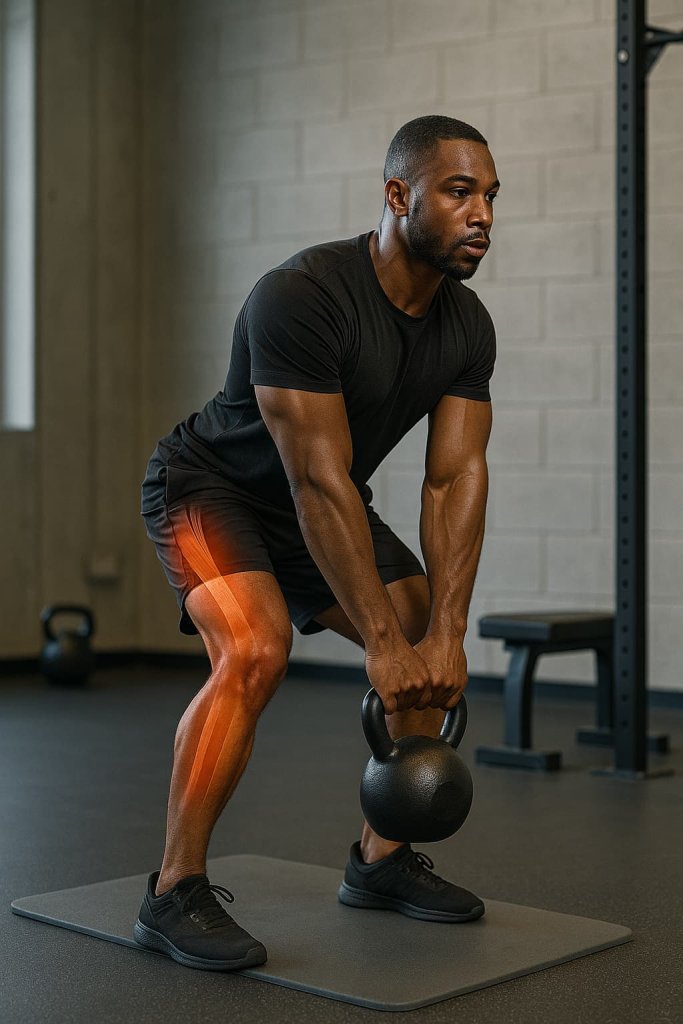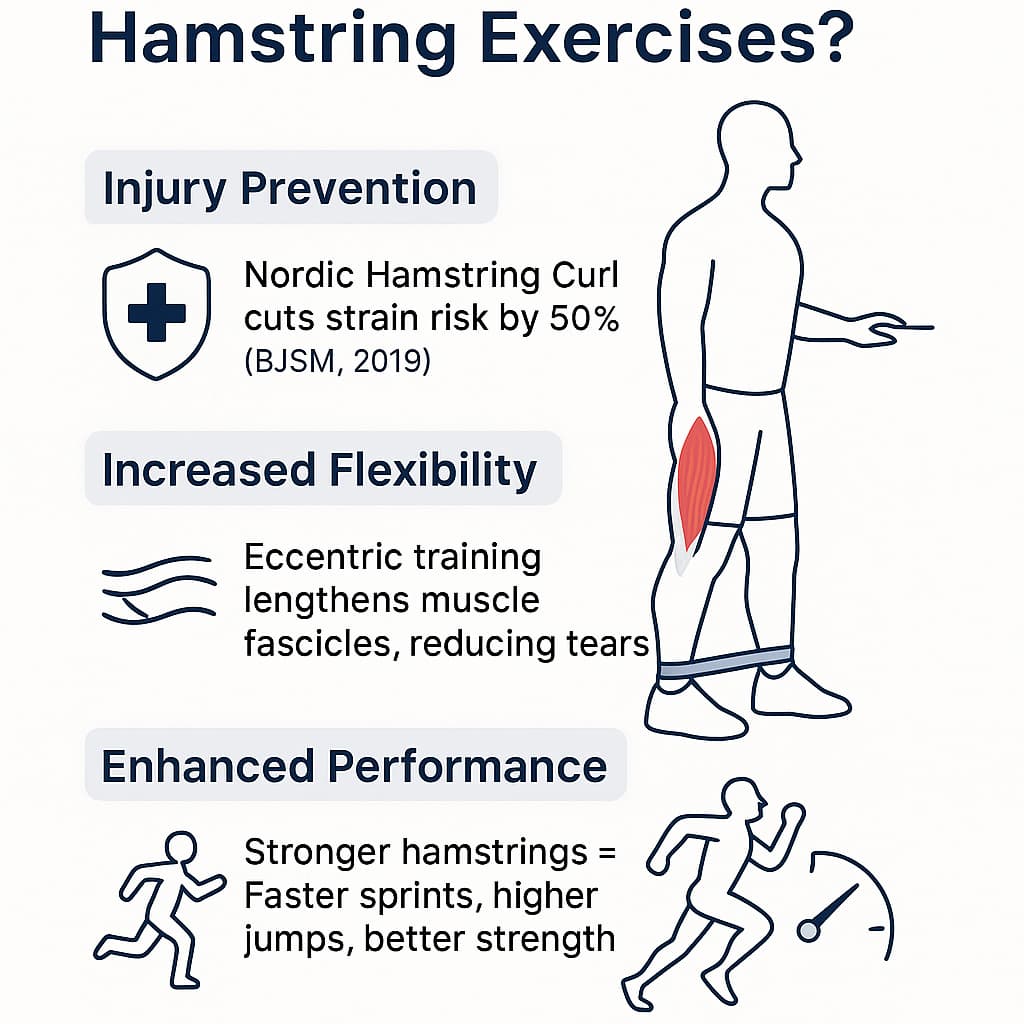Eccentric hamstring exercises are the most effective way to boost strength, prevent injuries, and support athletic performance. Eccentric training means focusing on the “lengthening” phase of muscle movement—where you lower the weight or control resistance as the muscle stretches. This style of training has been shown to build stronger, more resilient hamstrings and dramatically lower your risk of strains and tears (NCBI, 2022).

Understanding how and why to use eccentric hamstring exercises can help athletes, fitness enthusiasts, and anyone recovering from injury. In this guide, you’ll discover the top eccentric hamstring moves, the science behind their effectiveness, and actionable tips for making them part of your routine.
- Eccentric hamstring exercises lengthen and strengthen muscles better than conventional training.
- They can be done at home or in the gym, often with minimal equipment.
- Start with basic movements and progress to advanced variations for the best results.
What Is Eccentric Hamstring Training?
Eccentric vs. Concentric Training
- Eccentric movement: Muscle lengthens under tension (e.g., lowering phase of a leg curl).
- Concentric movement: Muscle shortens (e.g., curling the leg upward).
- Eccentric training stimulates more muscle fibers, enhances flexibility, and supports muscle growth (ScienceDirect, 2024).
Why Focus on Eccentric Hamstring Exercises?

- Injury prevention: Research shows eccentric exercises, especially the Nordic Hamstring Curl, can reduce hamstring strain risk by up to 50% in athletes (BJSM, 2019).
- Increased flexibility: Eccentric training increases muscle fascicle length, making hamstrings less prone to pulls and tears (ScienceDirect, 2024).
- Enhanced performance: Stronger hamstrings improve sprint speed, jumping power, and overall lower-body strength.
The 10 Best Eccentric Hamstring Exercises (Trainer Approved)
1. Nordic Hamstring Curl
How to Do It:
- Kneel on a padded surface with ankles secured.
- Slowly lower your torso forward, resisting the fall with your hamstrings.
- Catch yourself with your hands, then push back to the start.
Benefits: Proven to reduce injury rates in athletes. Superior eccentric overload (Self, 2024).
2. Single-Leg Romanian Deadlift (SL RDL)
How to Do It:
- Stand on one leg, holding a dumbbell or kettlebell.
- Hinge at the hips, lowering the weight slowly while your free leg extends behind you.
- Keep a slight bend in your knee, then return to standing.
Trainer Tip: Focus on a slow 3–4 second lower for max eccentric work.
3. Lying Leg Curl (Eccentric Emphasis)
How to Do It:
- Use a leg curl machine.
- Curl the weight up with both legs, then slowly lower with one leg for a 3–5 second negative.
Why It Works: Controlled lowering maximizes eccentric stimulus, improving hamstring strength (Wikipedia).
4. Glute-Ham Raise
How to Do It:
- Start on a glute-ham developer.
- Lower your body slowly, controlling the descent.
- Contract your hamstrings to return.
Pro Insight: Builds eccentric strength and improves posterior chain muscle balance.
5. Slider Hamstring Curl
How to Do It:
- Lie on your back with heels on sliders or towels.
- Bridge hips up, then slowly extend your legs while keeping hips high.
- Pull feet back to start.
Variation: Try single-leg version for more challenge.
6. Stiff-Leg Deadlift (Eccentric Focus)
How to Do It:
- Stand with feet hip-width, holding a barbell.
- Lower slowly, feeling a stretch in the hamstrings.
- Pause, then return to standing.
Science Note: Slow tempo increases muscle length and strength.
7. Razor Curl
How to Do It:
- Kneel on a pad, anchor heels, and lean forward with control.
- Lower as far as possible, then return.
Why Trainers Love It: Great progression for athletes working toward full Nordics.
8. Single-Leg Stability Ball Curl
How to Do It:
- Lie on your back with one foot on a ball, bridge hips, and slowly curl ball toward you.
- Extend leg to start position, keeping control.
Added Benefit: Improves unilateral hamstring strength and stability.
9. Kettlebell Swing (Slow Negative)
How to Do It:
- Swing kettlebell up, then control the lowering phase to increase eccentric load.
Trainer Tip: Focus on resisting the downward pull.
10. Toes-Elevated Romanian Deadlift
How to Do It:
- Stand on plates or a platform, toes elevated.
- Lower slowly, maximizing the stretch in hamstrings.
Why It’s Effective: Increases stretch and eccentric tension, enhancing flexibility.
How to Program Eccentric Hamstring Exercises
- Warm up with light cardio and dynamic stretches.
- Begin with 2–3 exercises, 2–4 sets each, focusing on slow, controlled movement.
- Use 3–5 second lowering phases for each rep.
- Rest 48–72 hours between hard eccentric sessions to allow for recovery.
Common Questions
Can I do eccentric hamstring exercises at home?
Yes! Many moves, like sliders and single-leg RDLs, require only simple equipment.
How often should I train eccentrics?
2–3 times per week is optimal for most people.
Are these safe for beginners?
Start with bodyweight and slow progressions; avoid advanced moves until your strength improves.
Authoritative References & Resources
- NCBI – Eccentric exercise and muscle adaptation (2022)
- ScienceDirect – Effects of Eccentric Training (2024)
- BJSM – Eccentric hamstring exercise & injury prevention (2019)
- Self – How to Master the Nordic Curl (2024)
Conclusion
Eccentric hamstring exercises are backed by science and trusted by trainers for building bulletproof hamstrings. Add these to your program to increase strength, boost flexibility, and protect yourself from injury. Start with simple moves, progress at your own pace, and feel the difference in performance and resilience.
